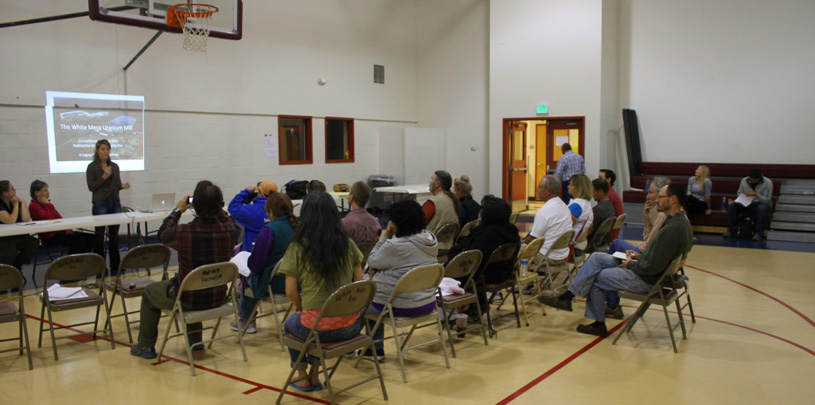

by Frankie Beesley, Citizen Advocacy Volunteer Coordinator, AmeriCorps
The drive from Flagstaff to White Mesa, Utah takes you through reservation lands—flat expanses and high mesas, yellow cottonwood leaves peeking through the canyons snaking through Monument Valley and redrock formations. Trust Energy Program director Anne Mariah Tapp and I took in the scenery when we hit the road late last month to attend a community meeting. The subject? The Environmental Protection Agency’s (EPA) proposed revisions to the national emissions standards for radon emissions from operating uranium mills—a regulation that applies to the White Mesa Mill, the only operating conventional uranium mill in the United States. The EPA has proposed a revision that relaxes the existing standards when the agency should be enhancing them. The small White Mesa community of the Ute Mountain Ute Tribe stands to be the most affected since it sits only a few miles from the White Mesa Mill.
We entered the gym at the White Mesa Community Center on the Ute Mountain Ute Reservation not knowing exactly what to expect. How many people would come? Did we get the word out in time? Would members of the tribal council show up? In a community where subsistence hunting is common and the mill is one of the only employers, would we be welcome?
We set up our Power Point, laid out sign-up sheets, information on how to send a letter to the EPA, and a giant map showing sites across the U.S. that ship their waste to the White Mesa Mill. Across from us was the gym’s scoreboard, a gift of Denison Mines Corporation, who sold the mill to its current owner, Energy Fuels. By 6 p.m. only about 10 people had drifted in. Children horsed around, sliding on the gym’s waxy floor. But by the time we began the presentation at 6:30, over 30 people from local towns as well as surrounding areas like Moab, Utah, and Cortez and Durango, Colorado were seated in the rows of fold-out chairs facing us. They included members of the Ute Mountain Ute Tribe, a family that works at the White Mesa Mill, concerned citizens from Bluff, Blanding, and Monticello, and representatives from the environmental department for the tribe.
Anne Mariah, along with Sarah Fields of Uranium Watch, Jennifer Thurston of the Information Network for Responsible Mining, and Mike King of the Ute Mountain Ute Tribal Environmental Department, started off with a brief history of uranium mining across the Colorado Plateau before homing in on the White Mesa Mill and the proposed revisions to the radon regulation. A brief explanation of radon followed. The invisible, odorless, radioactive gas attaches to dust particles and is easily breathed in; it’s a known carcinogen. Because it’s dangerous to human and environmental health, radon is regulated under the Clean Air Act as a hazardous air pollutant. For the last two years, the White Mesa Mill has exceeded the numeric emission standard for radon. But rather than enforce that standard, the EPA has proposed to eliminate it.
After hearing about the harm radon emissions can cause, one man, a tribal member living in White Mesa, wanted the straight facts:
“Does this or does this not cause cancer? If we hunt and fish in the nearby area and our game is drinking the water that is contaminated, will this affect our health?”
Probably, the panel said, but the man kept asking, “Will this make us sick?” Finally, he got a blunt “yes.”
In my opinion, the EPA should be strengthening radon emissions regulations, not weakening them. The health of the people of White Mesa— those we met in the gym that night and many others—and the air they breathe are at risk. The comment period on the new rule ended October 29th. The EPA is expected to issue a new rule sometime this spring.
Join our mailing list to stay up-to-date on this and other related issues.
*This blog entry was updated on 10/5/2016.
A small victory in the legal case challenging Daneros uranium mine, near Bears Ears National Monument.
Read MoreGroundwater pumping at a uranium mine near the Grand Canyon will affect the canyon's springs, scientists says.
Read MoreA rally in Salt Lake City followed by a spiritual walk in White Mesa demonstrate the Ute community's determination to see uranium mill close.
Read More